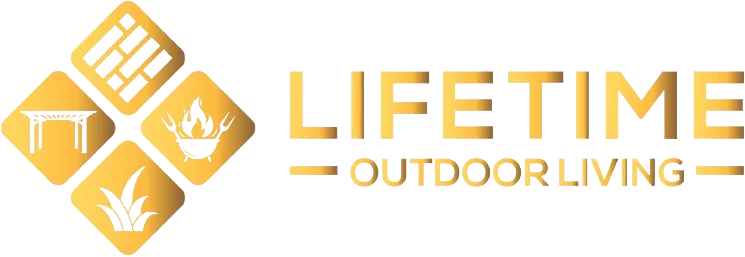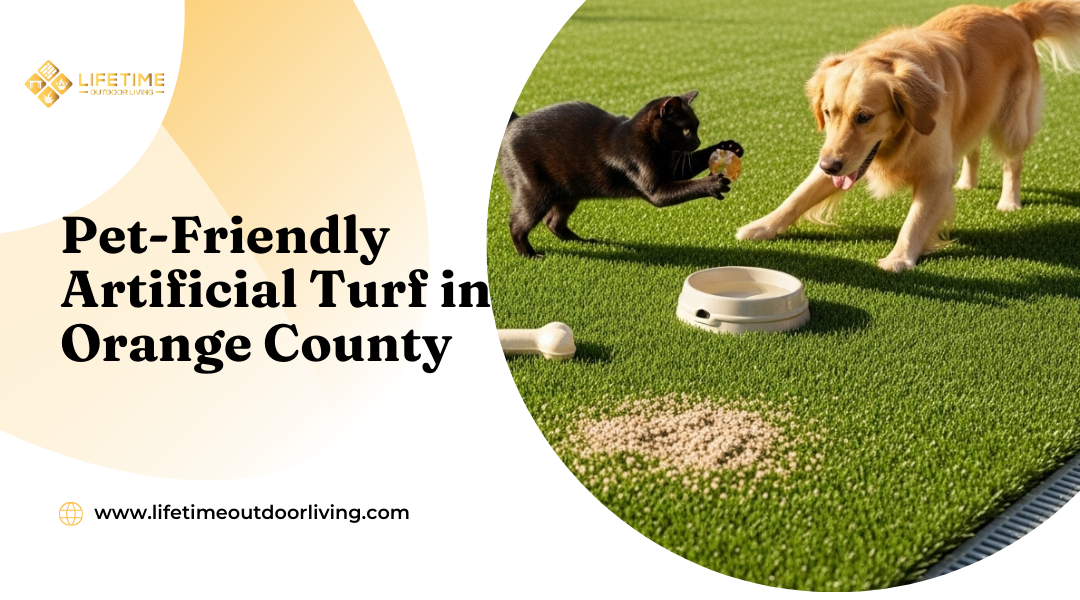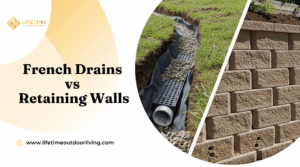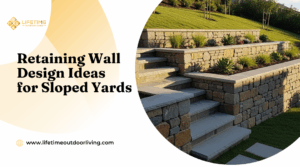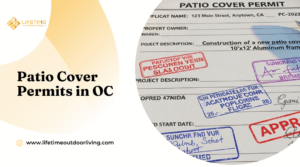Pet-Friendly Artificial Turf for Orange County Homes: The Complete Guide
If you’re a pet owner in Orange County, you know how challenging it can be to keep a natural lawn looking clean, safe, and green year-round. Between digging, muddy paws, and the constant need for watering, traditional grass often feels more like a chore than a benefit. Pet-friendly artificial turf gives you a durable, low-maintenance solution that keeps your outdoor space beautiful while making life easier for both you and your pets.
With the right turf system, you can create a yard that stands up to heavy play, drains quickly to prevent odors, and stays comfortable even on warm Southern California days. This isn’t just about replacing grass—it’s about designing a functional space that works for your lifestyle and your pets’ needs.
At Lifetime Outdoor Living in Laguna Beach, you have access to premium turf options tailored for Orange County homes. Their approach combines expert installation, proper base preparation, and quality materials to ensure your yard looks great and performs well for years. Whether you want a simple pet zone or a complete backyard upgrade, the focus is on creating a space that’s both practical and inviting.
Why Pet-Friendly Turf Makes Sense In Orange County
Artificial turf designed for pets helps you conserve water, reduce yard mess, and create a safe, comfortable space for your animals. It also cuts down on time spent maintaining your lawn while keeping your home cleaner and more enjoyable.
Water Savings And Drought Resilience
Orange County faces ongoing water restrictions and high costs for irrigation. Natural grass requires frequent watering, especially in hot months, while pet-friendly turf eliminates this need almost entirely. You save thousands of gallons of water each year and lower your utility bills.
Unlike live grass, synthetic turf stays green without fertilizers or pesticides. This reduces chemical runoff into local waterways and helps you meet California’s strict water conservation goals.
Many turf products also feature efficient drainage systems. These allow rain and pet waste to pass through quickly, preventing puddles and soggy patches that waste water and damage soil. For homeowners, this means a lawn that looks consistent year-round without the stress of drought conditions.
Cleaner Homes: No Mud, Less Tracking
When pets play on natural grass, they often drag mud, dirt, and grass clippings into your home. Rain or overwatering makes the problem worse, leading to constant cleaning. Pet-friendly turf solves this issue by removing bare patches and muddy spots.
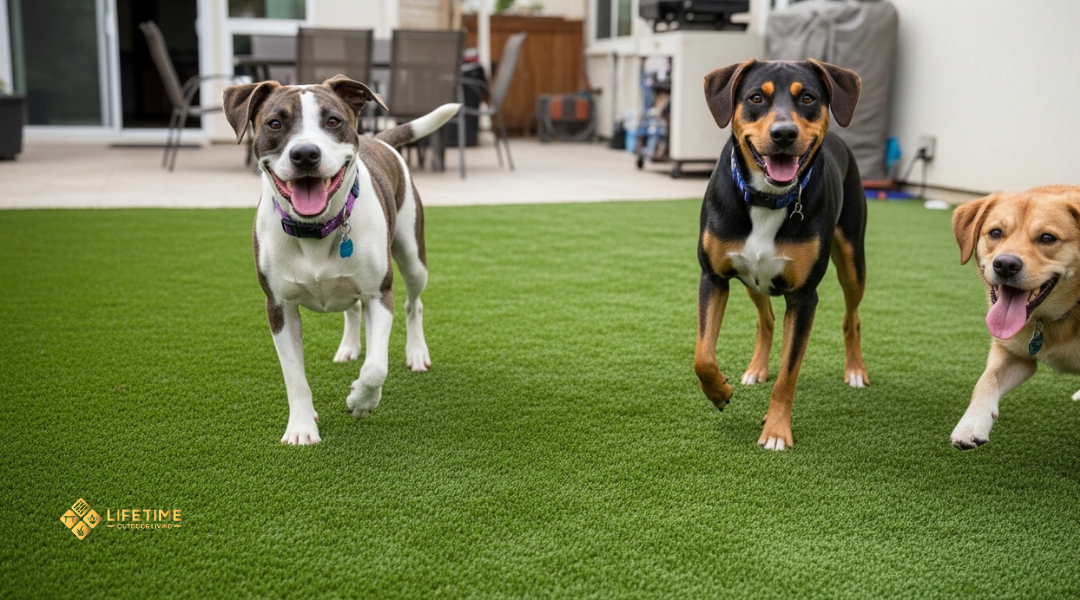
The surface is designed to resist digging and wear, so your yard stays intact even with active dogs. With turf, paws stay cleaner, which means your floors, carpets, and furniture do too.
You also avoid the buildup of odors that can come from wet soil. Modern turf systems use antimicrobial infill and fast drainage to keep bacteria and smells from developing. This makes your outdoor space more hygienic and easier to maintain.
Comfort For Paws And Low Upkeep For Owners
Pet-friendly turf is built with soft, durable fibers that stay comfortable underfoot. Unlike concrete or gravel, it doesn’t scrape paws, and unlike natural grass, it won’t develop dry, prickly patches. Some turf products even include cooling technology that reduces heat on sunny days.
For you, upkeep is simple. You only need to rinse the surface occasionally and brush fibers to keep them upright. No mowing, fertilizing, or reseeding is required.
This balance of comfort and low maintenance gives you more time to enjoy your yard with your pets instead of spending weekends on lawn care. It also ensures your outdoor space remains safe and inviting for years.
What Makes Turf “Pet-Friendly”: Key Specs
Pet-friendly turf depends on how it feels under paws, how well it drains, and how it resists odors and sun damage. The right combination of these features makes your yard easier to maintain and safer for your pets.
Pile Height And Density For Comfort And Cleanup
Pile height affects both comfort and cleaning. Shorter blades, usually around 1.0–1.25 inches, make it easier to rinse away waste and prevent debris from getting trapped. Taller blades, closer to 1.5–1.75 inches, create a softer surface but may require more upkeep.
Density also matters. A dense turf feels cushioned and resists flattening from play, but it can hold odors longer if not cleaned regularly. Lower-density turf drains faster but may look less natural.
For most pet owners, a medium pile height with moderate density provides the best balance. It gives your dog a comfortable surface while keeping maintenance manageable.
Quick guide:
- 1.0–1.25 in. = easier cleaning, less natural look
- 1.5–1.75 in. = softer feel, more frequent upkeep
- Medium density = balance of comfort and drainage
Permeability And Backing (PU Vs. Latex)
Drainage is one of the most important features for pet turf. Liquids need to pass through quickly to avoid standing water and odor buildup. Look for turf with perforated backing that allows at least 30–60 inches of water per hour to drain.
Backing material also makes a difference. Polyurethane (PU) is stronger, less likely to expand or contract with weather changes, and resists pet urine damage. Latex is more affordable but can absorb moisture and break down faster in humid or hot conditions like Orange County.
If you want long-term durability, PU-backed turf is usually the better choice. Latex may work for smaller spaces or lighter use but often requires earlier replacement.
Antimicrobial/Odor Control Tech And UV Stabilization
Pet turf should include built-in odor control. Some products use antimicrobial coatings that limit bacteria growth, while others pair with special infill materials that neutralize ammonia from urine. These features reduce the need for constant deep cleaning.
UV stabilization is also key in sunny climates. Without it, turf fibers can fade, weaken, or become brittle. Look for turf labeled as UV-resistant to ensure it holds color and texture under strong California sun.
When combined, antimicrobial protection and UV stabilization help keep the turf safe, clean, and visually consistent over time. This reduces both odor issues and long-term maintenance needs.
Base Prep And Drainage: The Odor-Free Foundation
A turf system that stays clean and odor-free depends on the right foundation. The materials you choose, the way you manage drainage, and how you secure seams all play a direct role in how well your lawn performs over time.
Sub-Base Materials (Crushed Rock Vs. DG) And Compaction
The sub-base gives your turf stability and allows water and pet waste to drain properly. In Southern California, two common options are crushed rock and decomposed granite (DG).
Crushed rock, usually ¾” minus or ⅜” minus, provides strong drainage and resists shifting. DG is finer and compacts tightly, which creates a smoother surface but can restrict water flow if not installed correctly.
For pet-friendly turf, crushed rock is often the better choice because it prevents puddling and odors. DG may hold moisture longer, which can increase bacteria growth.
After selecting your base, you need to compact it with a plate compactor. Aim for at least 90% compaction to prevent settling. A well-compacted base keeps the turf even and reduces wrinkles or dips.
Grading, French Drains, And Edge Restraints
Proper grading ensures water moves away from your home and does not collect under the turf. You should slope the base at least 2% away from structures to guide runoff in the right direction.
In areas with heavy water flow or poor soil drainage, a French drain may be necessary. This system uses perforated pipe wrapped in filter fabric and surrounded by gravel to carry water away from the yard. It prevents standing water and helps control pet odors.
Edge restraints are also important. Without them, the base material can spread or wash out. You can use concrete curbing, treated lumber, or bender board. Secure edges keep the turf tight and extend the life of the installation.
Seam Layout And Adhesives That Hold Up
Seams are one of the first places where turf can fail. Plan your layout so seams run in less visible areas and follow the same grain direction. This reduces the chance of noticeable lines.
For joining, you can use seaming tape with turf adhesive or specialized turf staples. Adhesive is stronger in high-traffic or pet-heavy yards, while staples can be used in lighter-use areas.
Choose adhesives rated for outdoor use and resistant to moisture. A quality adhesive prevents separation when turf gets wet from cleaning or rain. Combined with proper seam placement, this keeps the surface durable and odor-free.
Infill Options For Pets: Pros And Cons
Choosing the right infill helps control odors, improves drainage, and keeps the surface safe for your pets. Each material has unique benefits and drawbacks that affect cleaning, comfort, and long-term performance.
Zeolite For Ammonia/Odor Control
Zeolite is a natural mineral often used to reduce pet odors. It works by trapping ammonia from urine before it turns into an unpleasant smell. This makes it a strong choice if you want to minimize odor in high-use areas like dog runs or backyards.
You can use zeolite as a full infill or mix it with other materials. It absorbs liquids well, but heavy rain may wash some of the trapped ammonia back out, requiring periodic rinsing.
Pros:
- Effective at controlling urine odors
- Natural and non-toxic
- Safe for pets and children
Cons:
- Can lose effectiveness over time and need refreshing
- May not provide as much cooling as coated sand options
- Requires maintenance to keep it working properly
Coated Sand/Envirofill For Hygiene And Cooling
Coated sand, often sold under names like Envirofill, is another popular option. Each grain is coated with an antimicrobial layer that helps prevent bacteria, mold, and mildew growth. This reduces odors and keeps the turf cleaner for longer periods.
It also reflects heat better than many other infills, which helps keep the turf cooler on hot days in Orange County. This makes it more comfortable for pets to walk and play on.
Pros:
- Built-in antimicrobial protection
- Provides cooling benefits in warm climates
- Long-lasting and low maintenance
Cons:
- Higher cost compared to basic sand or zeolite
- Heavier weight may require more effort during installation
- Does not absorb urine directly, so rinsing is still needed
Mixing Infills And Proper Application Rates
You don’t have to rely on a single infill type. Many homeowners mix zeolite with coated sand to balance odor control and hygiene. This approach gives you the odor-absorbing benefits of zeolite while still adding antimicrobial and cooling features from coated sand.
Application rates are important. Too little infill can cause the turf blades to flatten and reduce drainage. Too much can make the surface hard and uncomfortable.
A general guideline is 1–2 pounds of infill per square foot, but the exact amount depends on turf pile height, pet traffic, and your yard’s drainage system. Following the manufacturer’s instructions ensures the turf performs as intended and lasts longer.
Heat, Comfort, And Safety Considerations
Artificial turf can become hot under direct sunlight, and not all products are equally safe or comfortable for pets. Choosing the right materials and design features helps reduce surface temperatures, protect paws, and ensure your yard remains a safe play area.
Cooling Strategies: Shade, Light Colors, Cooling Infills
Direct sunlight can raise turf temperatures, especially in warm climates like Orange County. You can lower surface heat by installing turf in areas with partial shade from pergolas, umbrellas, or trees.
Lighter-colored turf fibers absorb less heat than darker shades. While they may not look as deep green, they can make the surface more comfortable for pets.
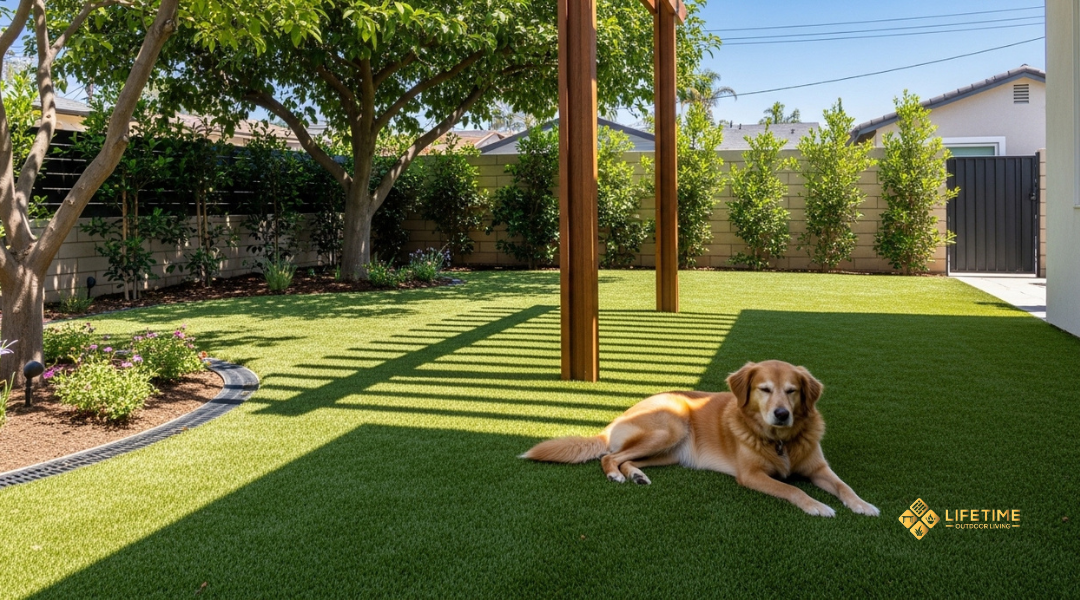
Specialized cooling infills are another option. These materials, often made from coated sand or mineral blends, reduce heat retention and release moisture slowly for evaporative cooling. Unlike rubber infills, they stay cooler and are safer for pets.
Combining shade, lighter tones, and cooling infills provides the most effective results. This approach keeps turf usable during hot afternoons and reduces the risk of discomfort for your pets.
Slip Resistance And Paw-Safe Textures
Artificial turf should provide traction for both pets and people. A quality turf product will have a non-slip backing and a surface texture that prevents sliding, even when wet.
Look for blades with a soft but springy texture. This helps protect paws from abrasions while still holding up to running and digging. Dense pile height also adds cushioning, which reduces the chance of slips.
Some turfs include woven thatch layers that stabilize the surface and prevent matting. This feature keeps the turf more consistent underfoot, especially in high-traffic areas.
For safety, avoid surfaces that feel overly slick or stiff. A paw-safe texture should balance comfort and durability, ensuring pets can play without risk of burns or scrapes.
Lead-Free Materials And Certifications To Verify
Not all artificial turf is made with the same standards. You should confirm that the product is lead-free and free from other harmful chemicals. Many reputable manufacturers provide safety certifications that verify compliance with U.S. and California regulations.
Look for independent testing results, such as ASTM standards or prop 65 compliance. These show the turf has been tested for heavy metals and toxins.
Some products also advertise non-toxic polyethylene or polypropylene fibers, which are considered safe for pets and children. Always request documentation from your installer to confirm these claims.
By checking certifications, you reduce health risks and ensure your turf is both safe and long-lasting.
Designing Smart Pet Zones
Creating a pet-friendly yard means planning spaces that work for both you and your pets. You need areas that handle daily activity, manage waste, and stay clean with minimal effort. Good design also blends turf with hardscape features to keep your outdoor space functional and attractive.
Dedicated Dog Runs Vs. Blended Lawns
A dog run gives your pet a defined space to play, exercise, and relieve themselves. This setup makes cleaning easier and prevents heavy wear on the rest of your yard. With artificial turf, you avoid muddy spots and keep the area usable year-round.
A blended lawn design mixes pet turf with the main yard. This option works well if you want your dog to share the same space you use for gatherings or relaxation. It requires more attention to cleanliness but gives your pet more freedom.
Key differences:
| Feature | Dog Run Only | Blended Lawn |
|---|---|---|
| Maintenance | Easier | Moderate |
| Yard Wear Protection | High | Lower |
| Pet Freedom | Limited | Greater |
| Best For | High-energy dogs | Families who want shared space |
Relief Areas, Rinse Stations, And Drainage Tiles
A relief area helps you manage pet waste in a specific spot. By training your dog to use this zone, you reduce cleanup across the yard. Artificial turf in these areas should include fast-draining backing to prevent odors.
Adding a rinse station makes cleaning quick. A simple hose hookup or outdoor faucet lets you wash down turf after use. For frequent use, drainage tiles under the turf improve flow and keep surfaces dry.
You can also use odor-control infill designed for pet turf. This material absorbs moisture and reduces bacteria growth. Together, these features keep your yard hygienic without adding much maintenance time.
Integrating Pavers, Gravel Bands, And Planters
Pavers create stable walkways that protect turf from heavy foot traffic. They also give you a clean path for moving through the yard without disturbing pet zones. Gravel bands work well as borders to separate turf from garden beds or patios.
Planters add greenery without leaving exposed soil for digging. Raised beds are especially useful since they keep plants out of reach while defining yard sections.
By combining turf with these hardscape elements, you balance durability with appearance. You also reduce wear on turf edges, which often see the most stress from running and turning. This layered design makes the yard easier to maintain while staying pet-friendly.
Maintenance Routines That Actually Work
Keeping pet-friendly turf in good condition requires steady care. You need to manage waste quickly, rinse and sanitize the surface, and handle deeper maintenance during the year. Local climate also plays a role, especially near the coast where humidity can increase odor issues.
Daily/Weekly Cleaning (Solids, Hose-Downs, Enzyme Cleaners)
Pick up solid waste as soon as possible to prevent bacteria and staining. Use a pooper scooper or waste bag and dispose of it properly. Leaving waste on the turf for even a short time can cause discoloration and odors.
Rinse the turf with a garden hose at least a few times per week. A light hose-down helps dilute urine and keeps fibers free of dust and debris. Focus on areas your dog uses most often.
For urine odor that lingers, apply an enzyme cleaner. These products break down organic material at the source instead of just covering the smell. Spray the cleaner evenly, let it sit for the recommended time, then rinse with water.
A simple routine looks like this:
- Daily: Remove solids
- 2–3 times per week: Hose down pet areas
- As needed: Apply enzyme cleaner to high-use spots
Seasonal Deep Clean And Decompaction
Over time, turf fibers and infill can compact from foot traffic and pet use. This reduces drainage and makes the surface less comfortable. A seasonal deep clean helps restore both appearance and function.
Start by rinsing the entire turf thoroughly with a hose. Then use a mild detergent mixed with water to scrub problem areas. Always rinse afterward to remove soap residue.
Decompaction involves brushing or raking the turf to lift flattened fibers and loosen infill. A stiff-bristle turf broom works well for this. In larger yards, you may consider professional equipment to refresh the surface.
Plan to do this two to four times per year depending on how often your pets use the space. This keeps the turf draining properly and prevents matting.
Odor Control In Coastal Humidity
Orange County’s coastal climate brings higher humidity, which can trap odors in turf. Moist air slows evaporation, giving bacteria more time to grow. You’ll need extra steps to stay ahead of smells.
Regular rinsing is more important in these conditions. A quick hose-down in the morning or evening can reduce buildup. Enzyme cleaners also work best when used before odors become strong.
You can also use turf deodorizers designed for pet areas. These products neutralize odor molecules and leave the surface fresher between deep cleanings. Choose products labeled safe for pets and synthetic turf.
Good drainage is another key factor. Make sure your turf installation allows water and urine to flow through the base layer. If water pools under the surface, odors will return quickly in humid weather.
Cost, Warranty, And Lifespan
The cost of pet-friendly turf depends on the type of materials, how easy it is to access your yard, and what site work is needed before installation. Warranties vary by brand and installer, and knowing what they cover helps you avoid surprises. Planning for repairs or eventual replacement ensures your turf investment lasts as long as possible.
Price Drivers: Turf Spec, Access, Site Conditions
The price of turf installation is shaped by three main factors: the turf itself, how easily installers can reach your yard, and the prep work required.
Turf specification matters most. Premium pet turf often includes thicker blades, antimicrobial backing, and advanced drainage. These features increase durability and hygiene but also raise the cost per square foot.
Access to your property also affects pricing. If installers must carry materials through narrow side yards, up stairs, or into hard-to-reach spaces, labor costs rise. Wide, open yards are faster and cheaper to install.
Site conditions include grading, soil removal, and base preparation. For example, a yard with compacted clay may need extra excavation and drainage layers, while a flat, sandy yard may require less work.
Typical installed costs in Southern California range from $8 to $15 per square foot, depending on these factors.
Warranty Terms And What They Cover
Artificial turf warranties vary, but most cover fading, premature wear, and defects in the backing. A manufacturer’s warranty usually lasts 8–15 years, depending on the product.
Coverage often excludes damage caused by improper installation, poor drainage, or misuse. For pet turf, warranties may not cover odor issues or damage caused by digging. That’s why choosing a contractor who installs with proper base layers and drainage is important.
Some installers, including specialized paving and turf companies, may also offer a workmanship warranty. This covers issues like seams separating or edges lifting, which are installation-related rather than product-related.
Always ask for warranty details in writing, including what voids the coverage. Compare both manufacturer and installer warranties to understand your protection.
Planning For Repairs And Replacements
Even with strong materials, pet turf will eventually show wear. High-traffic areas, such as dog runs or potty zones, may flatten or discolor faster than the rest of the yard.
You can plan ahead by asking your installer about replacement sections. Many turfs can be patched by cutting out worn areas and seaming in new pieces. This helps extend the overall lifespan without a full redo.
Regular cleaning and brushing also reduce long-term damage. Rinsing with water, using enzyme cleaners for pet waste, and brushing fibers upright can add years to the turf’s life.
Most pet-friendly turf lasts 10 to 15 years before full replacement is needed, depending on usage and maintenance. Factoring in future repair costs during budgeting helps you avoid unexpected expenses later.
HOA And City Considerations In Orange County
When you install artificial turf in Orange County, you must follow both city rules and HOA guidelines. These rules cover how your yard looks, how water drains through your turf, and where turf is allowed on your property.
Appearance Standards And Coverage Limits
Many HOAs in Orange County require turf to look natural and blend with the neighborhood. This means the color, pile height, and texture must resemble real grass. Some associations may also ask that turf be installed only in certain areas, such as lawns, and not on slopes or common areas.
Coverage limits are another factor. While California law protects your right to install drought-friendly landscaping, HOAs can still set reasonable standards. For example, they may require a mix of turf and live plants to maintain variety.
You should review your HOA’s architectural guidelines before starting. Submitting a sample of your turf product and a simple site plan often speeds up the approval process.
Stormwater/Permeability Requirements
Cities in Orange County pay close attention to drainage and stormwater management. Artificial turf must allow water to pass through to the soil below. If your installation does not meet permeability standards, you may face compliance issues.
A good turf system includes a permeable backing and a proper base layer of crushed rock. This prevents runoff and supports groundwater recharge. Some cities may also require that turf installations not increase stormwater flow onto sidewalks or neighboring properties.
When planning your project, you should ask your installer about drainage rates. For example, many high-quality products can drain 30+ inches of water per hour, which usually meets city requirements.
Front Yard Vs. Backyard Rules
Rules often differ between front yards and backyards. Front yards face more restrictions because they affect curb appeal and neighborhood character. Some HOAs limit the percentage of turf in front yards or require a balance of shrubs, mulch, and hardscape.
Backyards usually allow more flexibility. HOAs and cities are less strict because the space is private and less visible. However, drainage and safety standards still apply.
If you live in a community with shared spaces, such as walkways or parkways, turf may be restricted in those areas. Always confirm with your HOA and city before starting installation.
How Lifetime Outdoor Living Delivers Pet-Friendly Turf (Laguna Beach, CA)
You want a yard that is safe for pets, easy to maintain, and built to last in the Orange County climate. Lifetime Outdoor Living focuses on site planning, durable turf products, and professional installation methods that keep your outdoor space clean, comfortable, and functional.
On-Site Evaluation And Custom Design For OC Homes
Every project begins with an in-person evaluation of your property. The team checks soil conditions, slope, drainage, and how pets use the space. This helps create a plan that prevents puddling, odors, or uneven wear in high-traffic areas.
You also get input on layout and design. For example, you may want turf only in a pet run, or across the entire yard. Lifetime Outdoor Living adjusts the design so it fits your daily routine and your home’s style.
The company also considers Laguna Beach’s coastal climate. Salt air, sun exposure, and seasonal rain all affect turf performance. By tailoring the design to your location, you get a surface that holds up under local conditions while staying safe for your pets.
Premium Turf Lines, Infills, And Accessories We Recommend
The turf options include pet-specific synthetic grass that resists digging and stays cooler under the sun. These products use durable fibers that keep their shape even with heavy use. You can choose from different pile heights and textures depending on how much time your pets spend outside.
For infill, Lifetime Outdoor Living recommends pet-safe materials that reduce odor and improve drainage. Options include antimicrobial sand and specialized infill that prevents bacteria buildup. These choices make cleanup easier and keep the yard more sanitary.
Accessories such as border edging, drainage grids, and deodorizing systems can be added to improve performance. Edging keeps turf in place, grids help liquids drain quickly, and deodorizing layers reduce long-term smell. Each element is selected based on your yard’s layout and the number of pets you have.
Professional Installation, Care Guide, And Financing Options
Installation includes clearing old grass, grading the soil, and building a compacted base. This provides a stable foundation that prevents shifting. The turf is then secured with seams and edging so it stays tight and smooth, even with active pets.
After installation, you receive a care guide with simple steps: rinse urine spots, pick up waste promptly, and brush fibers upright. These tasks take little time but help extend the life of your turf.
Lifetime Outdoor Living also offers 0% financing options. This allows you to spread out the cost of your project without interest. Combined with free estimates and consultations, the process makes it easier to start your turf project right away.
Next Steps: From Quote To Installed
You move from estimate to installation through a clear process that includes selecting materials, preparing your space, and learning how to care for your new turf. Each step ensures that your yard is ready for long-term use and that you know what to expect before, during, and after the project.
Book A Design Consultation And Review Samples
You start by booking a consultation where you meet with a project specialist. During this meeting, you discuss your yard’s layout, how your pets use the space, and what type of turf will work best.
You review turf samples in person so you can see the texture, color, and thickness. This helps you compare options side by side and choose one that balances durability, comfort, and drainage.
At this stage, you also receive a written estimate. It breaks down materials, labor, and any add-ons like drainage systems or paver edging. Having this information upfront gives you a clear picture of costs before you commit.
Project Timeline, Scheduling, And Preparation Checklist
Once you approve the estimate, the installation team sets a project timeline. Most residential turf projects take 1–3 days, depending on the size of the yard and any extra features like pavers or custom edging.
You receive a preparation checklist so you know what to do before work begins. Common steps include:
- Remove personal items, furniture, or toys from the yard
- Ensure pets are kept indoors or off-site during installation
- Confirm access for vehicles and equipment
Scheduling is flexible, but it helps to plan for a time when you can be home for the first day. This way, you can review the layout and confirm details before installation starts.
Post-Install Walkthrough And Maintenance Plan
After the turf is installed, the crew walks you through the finished yard. They show you how the drainage works, where seams are joined, and how the infill supports the turf. You can ask questions and confirm that everything looks correct before the team leaves.
You also receive a maintenance plan tailored for pet use. This usually includes:
- Rinsing urine spots with water to prevent odor buildup
- Picking up solid waste promptly
- Brushing turf fibers upright every few weeks
By following these steps, you keep the turf looking clean and extend its lifespan. You also know what to expect if small adjustments or touch-ups are needed in the future.
